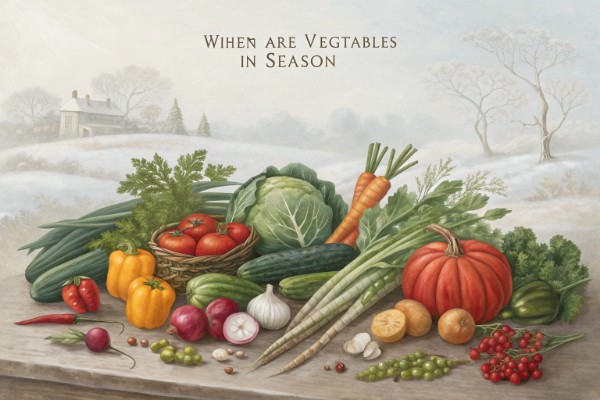What to Plant in October for a Beautiful Autumn Garden

What to plant in October
Wondering what to plant in October? Fill your beds now with dependable cool-season veggies like garlic, kale, and spinach to reap hearty harvests later. Autumn-planted bulbs, like daffodils and crocuses, root deeply now so they bloom boldly come spring. Here's your friendly, no-nonsense guide to what to plant in October to keep your garden thriving through fall and beyond.
Cheatsheet: October Planting for Fall Color
🍁 Cool-Weather Flowers
- Pansies & violas — Frost-tolerant, bloom till winter
- Mums — Plant early for best root growth
- Snapdragons — Scented, cold-hardy, fast to flower
- Cyclamen — Striking foliage, blooms above 45°F (7°C)
🥬 Autumn Edibles
- Spinach, kale, arugula — Sweeten after frost
- Garlic — Plant cloves; harvest early summer
- Radishes — Rapid maturity (3-4 weeks)
- Shallots & onions — Overwinter for spring
🌱 Spring-Ready Bulbs
- Tulips, daffodils, hyacinths — Plant at 40-55°F (4-13°C) soil
- Crocus & snowdrops — Earliest spring color
🌳 Trees & Shrubs
- Deciduous trees — Maple, dogwood, oak; root best in cool soil
- Evergreens — Plant before ground freezes
🧑🌾 Tools and Products You’ll Need
- Hand trowel
- Gloves
- Mulch — Preserves soil warmth
- Bulb planter
- Compost — Boosts soil
- Frost cloth (row cover)
📈 Quick Stats & Benefits
- Roots grow 2–3× faster in 50–60°F (10–16°C) soil
- Fall greens pack vitamins A & K
- Bulbs planted now yield 85-95% more blooms
- Spring bulbs return food & forage for pollinators
📝 Steps to Plant for Autumn Beauty
- Test soil temperature (aim: 40-60°F / 4-16°C)
- Amend beds with compost
- Plant bulbs 2-3× their height deep
- Sow greens & root veg in rows; water well
- Mulch all plantings, 2-3” (5-8 cm) thick
- Cover tender crops before hard frost
I plan October like a chef plans mise en place, tight windows and big payoffs. The trick is timing, soil temperature, and the right plants for your zone.
Spring bulbs love a cool start and dry feet, so I plant after the first chill when soil holds around 40 to 55 F, 4 to 13 C. I look for big calibers since larger bulbs throw more and better blooms.
- Tulips: plant deep, 6 to 8 in, 15 to 20 cm, and treat as annuals in warm or wet climates.
- Daffodils: truly perennial and deer tend to skip them, great naturalizers.
- Crocus and muscari: small bulbs, huge morale in late winter.
- Alliums: architectural globes, also deer resistant.
- Hyacinths and fritillaria: perfume and drama where drainage is sharp.
As a rule, I plant depth at roughly three times the bulb height and give them a dry-ish mulch. In mild zones, I refrigerate tulips and hyacinths 10 to 14 weeks at 35 to 45 F, 2 to 7 C, then plant.
Plant bulbs at a depth near three times their height and keep soil well drained for best returns. Source: Royal Horticultural Society guidance
I slide garlic and shallots into the ground by Halloween in zones 5 to 7, earlier up north, later down south. Hardneck types give me scapes in June and rich cloves by July, while softnecks store longer.
- Spacing: 6 in, 15 cm between cloves, 10 to 12 in, 25 to 30 cm between rows.
- Mulch: 2 to 3 in, 5 to 7.5 cm of clean straw after soil cools to 50 F, 10 C.
- Onion sets: short-day types in zones 8 to 10, day-neutral in 7 to 8, long-day for spring planting up north.
I plant plump cloves, point up, and label rows because winter snow erases memory faster than a café napkin. I have pulled 5 pounds, 2.3 kg from a single pound, 0.45 kg of seed garlic with steady moisture and a spring side-dress.
Typical garlic yield runs about 4 to 6 times planting weight with good fertility and weed control. Source: University Extension recommendations
Spinach, arugula, lettuce, and mâche love cool roots, and October sowings germinate cleanly once soil sits near 45 to 65 F, 7 to 18 C. I hedge with a light row cover to keep flea beetles and the first frosts at bay.
- Spinach: sow 1 inch, 2.5 cm apart, thin to 3 to 4 in, 7.5 to 10 cm, harvest baby leaves in 30 days.
- Asian greens: tatsoi, mizuna, komatsuna stay tender under covers.
- Herbs: cilantro, parsley, chervil, and dill germinate fast in cool weather.
- Scallions: sow thick, harvest like a clump all winter in zones 7 to 10.
I resow every 10 to 14 days for a rolling harvest. In zone 8 and warmer, I also sow shelling or sugar snap peas now for a late winter pop.
I tuck in transplants of kale, broccoli, cabbage, and collards now, because cool nights push sugars and the flavor turns honest. Broccoli side shoots keep me snacking to snowfall.
- Kale and collards: 18 in, 45 cm spacing, harvest lower leaves first.
- Kohlrabi: 8 in, 20 cm spacing, pick at tennis-ball size.
- Cauliflower: choose faster 55 to 65 day types for October sets.
I cover with 0.5 oz per sq yd, 17 g per m2 fabric after planting to bump temps and block moths. I pull covers on warm days to vent humidity and avoid mildew.
Floating row cover typically adds 2 to 4 F, 1 to 2 C of frost protection while reducing insect pressure. Source: University Extension trials
I slot in pansies and violas wherever I want color that survives a cold snap. Snapdragons, calendula, and ornamental kale carry borders into winter.
- Pansies and violas: plant 8 to 10 in, 20 to 25 cm on center, deadhead for waves of blooms.
- Ornamental cabbage and kale: strongest color arrives after nights hit 40 F, 4 C.
- Chrysanthemums: great containers now, set perennials earlier in the season for long life.
I water in with a seaweed solution for transplant shock. A light pine straw skirt saves blooms through 24 F, minus 4 C nights in my zone 7 beds.
Fall planting gives roots a head start while the top rests. I set woody plants while soil sits above 50 F, 10 C, and plan a slow, deep watering routine.
- Perennials: echinacea, rudbeckia, salvia, heuchera, and daylilies settle fast in cool soils.
- Shrubs: viburnum, spirea, hydrangea, and ninebark. In cold zones, plant evergreens earlier.
- Trees: maples, oaks, fruit trees where ground stays workable 6 to 8 weeks before hard freeze.
I dust roots with mycorrhiza at planting and keep mulch 3 in, 7.5 cm off the trunk flare. Staking is temporary and gentle, or not at all if the root ball is solid.
Fall is for planting because cooler air and warmer soil favor root growth and reduce stress. Source: Cooperative Extension messaging
After harvest, I sow cover crops to feed microbes and lock in nutrients. The soil smells alive in spring after a winter under green.
- Crimson clover or hairy vetch for nitrogen in zones 6 and up.
- Winter rye or wheat for biomass and weed suppression.
- Oats and field peas to winter-kill in zones 5 to 6 for easy spring prep.
- Daikon radish to punch through compaction and scavenge nutrients.
I mow and tarp rye 3 to 4 weeks before planting beds. Oats melt after single digits, leaving a tidy mulch in spring.
October sowing mimics natural cold stratification for many natives. I rake a clean seedbed, press seed for soil contact, and skip burying tiny seed.
- Prairie blend in the Midwest, lupines in the Northwest, bluestem mixes in the Plains.
- Region matters, so I buy ecotype seed from local producers.
I hold back on fertilizer to avoid favoring weeds. Patience pays, the first year often builds roots.
Fall sowing lets winter provide the chill many native seeds require to break dormancy. Source: Xerces Society guidance
Cool-season lawns respond well to October overseeding in many regions, especially after aeration. I time it while soil sits near 50 to 65 F, 10 to 18 C.
- Tall fescue: 5 to 8 lb per 1000 sq ft, 24 to 39 g per m2.
- Kentucky bluegrass: 2 to 3 lb per 1000 sq ft, 10 to 15 g per m2.
- Perennial ryegrass: 5 to 9 lb per 1000 sq ft, 24 to 44 g per m2 for quick cover.
I keep seed moist with short, frequent waterings until germination, then taper. A soil test guides my fall fertility so I feed roots, not false growth.
Ideal germination for cool-season turf happens while soil temperatures average roughly 50 to 65 F, 10 to 18 C. Source: University turf programs
- Zones 3 to 5: spring bulbs, garlic, shallots, cover crops, hardy perennials. Protect brassicas with heavy covers, 1 to 1.5 oz per sq yd, 34 to 51 g per m2.
- Zones 6 to 7: all bulbs, garlic, brassicas, salads, pansies, shrubs and trees. Last call for lawn overseeding by mid month.
- Zones 8 to 9: pre-chilled tulips and hyacinths, daffs, alliums, onions and shallots, peas, carrots, cilantro, broccoli, pansies. Plant strawberries now.
- Zones 10 to 11: cool herbs and greens, short-day onions, potatoes in frost-free pockets, annual color, pre-chilled bulbs only.
- Bulbs: choose firm, heavy bulbs, tulips 12 plus cm, daffodils 14 plus cm. Avoid soft spots and mold.
- Pre-chilled bulbs for warm zones save time, ask for 10 to 14 week chill verification.
- Seed quality: look for current lot tests and high germination percentages.
- Row cover: 0.5 oz per sq yd, 17 g per m2 for light frost, 1 oz, 34 g per m2 for heavier protection. Buy spring steel pins to anchor.
- Soil thermometer: small tool, big clarity on planting windows.
- Mulch: clean straw for garlic, shredded leaves for beds after soil cools.
- Tree stakes and straps: use only as needed, remove within a year.
- Soil test: lab test every 2 to 3 years steers pH, P, and K decisions.
- Week 1: plant garlic and shallots, sow spinach and arugula, order pre-chilled bulbs if in warm zone.
- Week 2: set pansies and violas, seed cover crops on empty beds, divide and move perennials.
- Week 3: plant tulips, daffs, and alliums, tuck in brassica transplants, overseed lawn.
- Week 4: plant trees and shrubs, sow wildflowers, mulch after a good rain once soil cools.
- Wait to mulch garlic until the soil cools to around 50 F, 10 C to avoid premature sprouting.
- Water in the morning to keep foliage dry by night and cut disease in half.
- Label bulb groups and snap a quick photo map, spring memory lies.
- Space for airflow, crowded brassicas sulk all winter.
- Row cover works only if edges are sealed, I use sand bags and pins every 3 ft, 1 m.
- Keep notes on variety performance, the garden will pay you back next fall.
"Plant the right thing at the right time and the garden repays with interest." Source: personal field notes, backed by Cooperative Extension calendars

Want smarter plant choices? 🪴
Frequently Asked Questions About October Planting
Which vegetables thrive when planted in October?
October offers cool, mild weather ideal for sowing leafy greens and root crops. Consider planting hardy vegetables like spinach, kale, Swiss chard, radishes, carrots, garlic, and onions. These crops germinate reliably at soil temperatures around 45–55°F (7–13°C).
Can bulbs be planted successfully during this month?
Yes, October provides optimal conditions for planting spring-flowering bulbs. Establish bulbs such as tulips, daffodils, crocuses, hyacinths, and alliums now to ensure vibrant blooms come spring. Plant bulbs at a depth approximately three times their diameter for healthy root establishment.
Is October suitable for adding fruit trees and berry bushes?
This month offers ideal conditions for planting dormant fruit trees and berry bushes. Cooler soil temperatures encourage root growth without stressing the plants. Popular choices include apple, pear, plum trees, as well as berry shrubs such as raspberries and currants.
How can gardeners protect newly planted seedlings from frost?
Protect October-planted crops from unexpected frost by applying a layer of mulch such as straw or shredded leaves around seedlings and newly planted bulbs. You may also use fabric row covers or gardening fleece to shield tender growth during nights when temperatures dip near freezing (32°F or 0°C).
Should annual flowers be planted during this month?
Hardy annual flowers sown during October—including pansies, violas, calendulas, and snapdragons—endure cooler conditions and develop robust roots throughout colder months. This preparation ensures colorful spring blooms following winter dormancy.
Is watering required frequently for plants established in October?
Cooler autumn weather typically reduces water loss from evaporation, yet regular watering remains essential for healthy root formation. Provide consistent moisture without excess saturation, approximately one inch (2.5 cm) of water weekly, adjusting for rainfall.
October is the month where soil still holds a bit of summer’s warmth and the air smells like change. Knowing what to plant in October isn’t just about squeezing in one last crop—it’s about setting up your garden for color, flavor, and vitality long after the first frost. Hardy greens, garlic, onions, and spring-flowering bulbs thrive now, while autumn-blooming perennials and cool-weather annuals keep the show going. If you’re hungry for even more from your beds, try nutrient-dense vegetables or experiment with a little companion planting for better yields. Every spade of earth you turn in October pays you back double come spring. So pull on your boots, trust your instincts, and let the season’s rhythm guide your hands—there’s still plenty to sow, and even more to enjoy.
The Homesteader’s Guide: October Plantings for Health, Harvest, and Self-Reliance
Boost Immunity with Medicinal Herbs
- Echinacea: Cold-hardy immunity herb; sow seeds ¼-inch (6 mm) deep in fertile soil, spacing 18 inches (45 cm) apart.
- Calendula: Edible flowers for skin salves; plant seeds shallowly, cover lightly, seedlings emerge within 5–15 days.
- Garlic: Rich in antioxidants; plant cloves 2 inches (5 cm) deep, tip upward, 6 inches (15 cm) apart for robust bulbs next summer.
Plant for Late-Autumn Harvests
- Winter radishes (Daikon): Rich in vitamin C, harvestable 60 days after planting; sow directly, ½-inch (12 mm) deep, rows 18 inches (45 cm) apart.
- Mache (corn salad): Cold-tolerant leafy green abundant in vitamins A and C; sprinkle seeds thinly in rows, cover lightly, pick after 50 days.
- Claytonia (Miner’s lettuce): Vitamin-rich edible leaves thrive in cool temperatures; scatter seeds evenly, minimal covering, harvest young for crisp salads.
Extend Crop Production Using Smart Techniques
- Cold frames: Build simple wood-and-glass frames facing south; maintain interior temperatures above freezing (32°F/0°C) for leafy plants all winter.
- Row covers: Lightweight fabric protection raised above crops to trap heat and defend against frost down to roughly 28°F (-2°C).
- Mulching: Apply thick layers (4 inches/10 cm) of straw or shredded leaf mulch around plants like kale and collards to moderate soil temperatures and retain moisture.
Care for Beneficial Pollinators in Autumn
- Leave perennial herb stems standing through winter for native pollinator habitats (bees overwinter in hollow stalks).
- Add late-blooming asters to encourage bees and butterflies through cooler weather.
- Provide shallow water sources with small stones for butterflies and bees needing hydration without drowning.
Find out which plants will thrive in your garden!
Answer a few fun questions and get custom plant recommendations perfect for your space. Let’s grow something amazing together!

start your season





